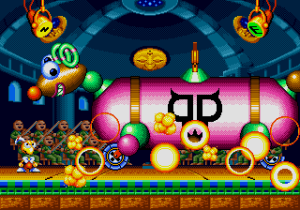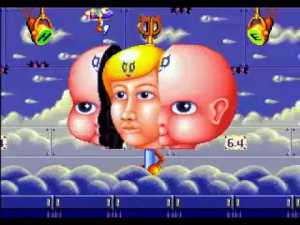Developer Treasure is known for their unique brand of game design, often taking popular genres and filling them with oddball characters and an insane level of action. Though they were made famous for their first game – Gunstar Heroes on the Sega Genesis – Treasure released another game on the same console which, although not as popular nor quite as good as Gunstar Heroes, greatly epitomizes Treasure’s approach to gaming.
That game was Dynamite Headdy, an action-platformer that, in many ways, is one of the best examples of the genre. But one whose immense difficulty may not make it to everyone’s liking.
While Gunstar Heroes was a run-and-gun platformer, Dynamite Headdy is a little more straightforward. Players take control of Headdy, a puppet-creature with a detachable head, which can be swapped out with other heads that give Headdy different abilities.
Headdy controls simply enough. The C button jumps, B performs your current head’s ability (Headdy’s standard attack is throwing his head in different directions), and the A button removes one of the power-up heads.
These additional heads come in a variety of forms, each bringing a different power. One head shrinks Headdy so that he’s more difficult for enemies to hit, and can explore areas he otherwise couldn’t. A shuriken head allows Headdy to stick to walls, which can uncover more paths throughout the stages. The hammer head doubles your damage output for a short time. The pig head shoots homing stars out of its snout. And a sleeping head heals Headdy, at the expense of making him temporarily immobile.
This is just a sample of the many heads Headdy can find, which are obtained by (how else?) throwing your head at little boxes held by one of the friendly characters.
Dynamite Headdy is separated into nine different worlds (called “scenes” here, as the whole game is presented like a stage play), each of which are separated into different sections, which work as stages, in the sense that they are each given a label like 2-1, 2-2, 2-3, and so forth, similar to Super Mario Bros. But calling them levels wouldn’t be entirely accurate, as some of the sections are just a singular boss fight, and others are just abrupt cinematic moments.
In case of the latter, it feels a little bit like a waste. When you reach a new level, you kind of want an actual level, not a single screen where you just walk for a few seconds to activate a cinematic. Though in the case of the former, the boss fights are plentiful, varied and really creative. Major bosses are referred to as “Keymasters” and are identifiable by their immense size by a key that’s visible on their person.
 The boss fights are a definite highlight of the game, and showcase Treasure’s unique brand of insanity (the first Keymaster is the game’s secondary antagonist – a teddy bear named Trouble Bruin – inside of a giant, inflatable wiener dog, with an orchestra playing a rendition of The Nutcracker Suite in the background). The good news is that the levels themselves showcase a similar variety, many of which take advantage of the Genesis’ graphical capabilities to the benefit of gameplay.
The boss fights are a definite highlight of the game, and showcase Treasure’s unique brand of insanity (the first Keymaster is the game’s secondary antagonist – a teddy bear named Trouble Bruin – inside of a giant, inflatable wiener dog, with an orchestra playing a rendition of The Nutcracker Suite in the background). The good news is that the levels themselves showcase a similar variety, many of which take advantage of the Genesis’ graphical capabilities to the benefit of gameplay.
One early level sees Headdy jumping on rotating platforms, with players able to move Headdy in either a two-dimensional or three-dimensional plane, depending on the current position of the platforms. Another stage has Headdy jumping vertically up a tower, which rotates as Headdy moves from platform to platform, all while avoiding another of Trouble Bruin’s contraptions, which will remove sections of the tower at a time. The entire sixth world changes the game’s genre to a shoot-em-up, with Headdy getting three heads unique to this section (a plane, a bird, and a rocket, each with different shooting patterns).
The sheer variety and creativity in the game’s levels and boss fights are among the best of any 16-bit platformer. And they are complimented by colorful graphics, quirky character designs, and a fun and catchy soundtrack.
What prevents Dynamite Headdy from reaching the top of the 16-bit platforming mountain, however, is its unforgiving difficulty. Thankfully, the game doesn’t start out ludicrously difficult, but once the challenge does pick up, it’s downright brutal. Later stages will often have enemies and dangerous projectiles coming from all sides, some of the bosses begin using attacks that are random (which just makes them feel unfair), and more one-hit kill deathtraps are introduced as the game progresses.
Perhaps worst of all, the game features one head that is intentionally useless, as it’s so heavy that Headdy can only crawl on the ground, unable to even jump. And unlike the other heads, you can’t manually remove it, and have to wait for its time to run out. While I can appreciate the joke at hand, the problem is that this “power-up” is often placed in the heat of boss battles, where it’s really easy to grab it by accident, at which point you’re basically screwed. Again, it’s a funny gag when you first see it, but given how difficult the later bosses already are, placing this useless item in the midst of them feels like taking the joke too far.
What really makes this high level of difficulty a detriment is that you have very limited lives, and the levels don’t feature checkpoints. Die once, and you have to start the current stage all over again (including tough-as-nails, multi-phase boss fights). Get a game over, and you have to start the game over from the beginning.

It is possible to refill health, by finding bananas (Headdy’s favorite food) or grabbing the aforementioned sleeping head, but extra lives are incredibly rare. What’s worse, the only way to get a continue is after defeating a Keymaster boss, where you have to grab a large amount of the orange cubes that pop out of the boss’ explosion. The number of cubes don’t stack with subsequent bosses, so if you don’t grab enough cubes after a single fight, you don’t have any continues.
There is a saving grace to this, however, as there’s an easy-to-learn cheat code you can use at the title screen to select a stage. Normally, I wouldn’t want to resort to such things, but with how brutally difficult Dynamite Headdy is, and how stingy it is with the extra tries, I had no other choice but to use the level select code to get back to the levels I kept dying on. I don’t think I could beat this game without it. Even with it, some of the later bosses took several attempts to take down.
Dynamite Headdy is a game that showcases Treasure’s approach to game design in a nutshell: It’s weird, action-packed, chock-full of memorable boss fights, aesthetically pleasing, and really creative. On the downside, Dynamite Headdy’s embodiment of all things Treasure also includes their notorious difficulty, which is taken to all new levels here. Dynamite Headdy is a great game in so many ways, but its lack of opportunities to tackle its challenges outside of cheat codes gives it a weird disconnect with the player. If a game is going to be this difficult, at least give me some extra lives!

I loved this game as a kid, but god damn, it’s brutal. Have you ever heard of Alien Soldier? It was also made by Treasure for the Genesis, but it never came outside of Japan until it got a digital rerelease on Virtual Console and Steam, that’s one of my favorite games on the system.
LikeLiked by 1 person
I’ve heard of Alien Soldier, but never played it. Mischief Makers was my childhood Treasure game, though. I will definitely check out Alien Soldier.
Dynamite Headdy is so great, but geez, those last few worlds are impossible without that level select code to give you extra tries.
LikeLike
Awww, I just passed up buying this game recently and I am regretting it a bit now. I’ll have to keep an eye out for it. Thanks for helping me to make a firm decision on the game!
LikeLiked by 1 person
I definitely recommend getting it, if you can get a hold of it.
LikeLiked by 1 person
Great review of a true Treasure! I agree that the bosses were a highlight and the most memorable/ridiculous parts of the game. That babyface boss is still nightmare-inducing.
LikeLiked by 1 person
Seems like a unique title! I’ll have to look for this around. Thanks for the review!
LikeLiked by 1 person